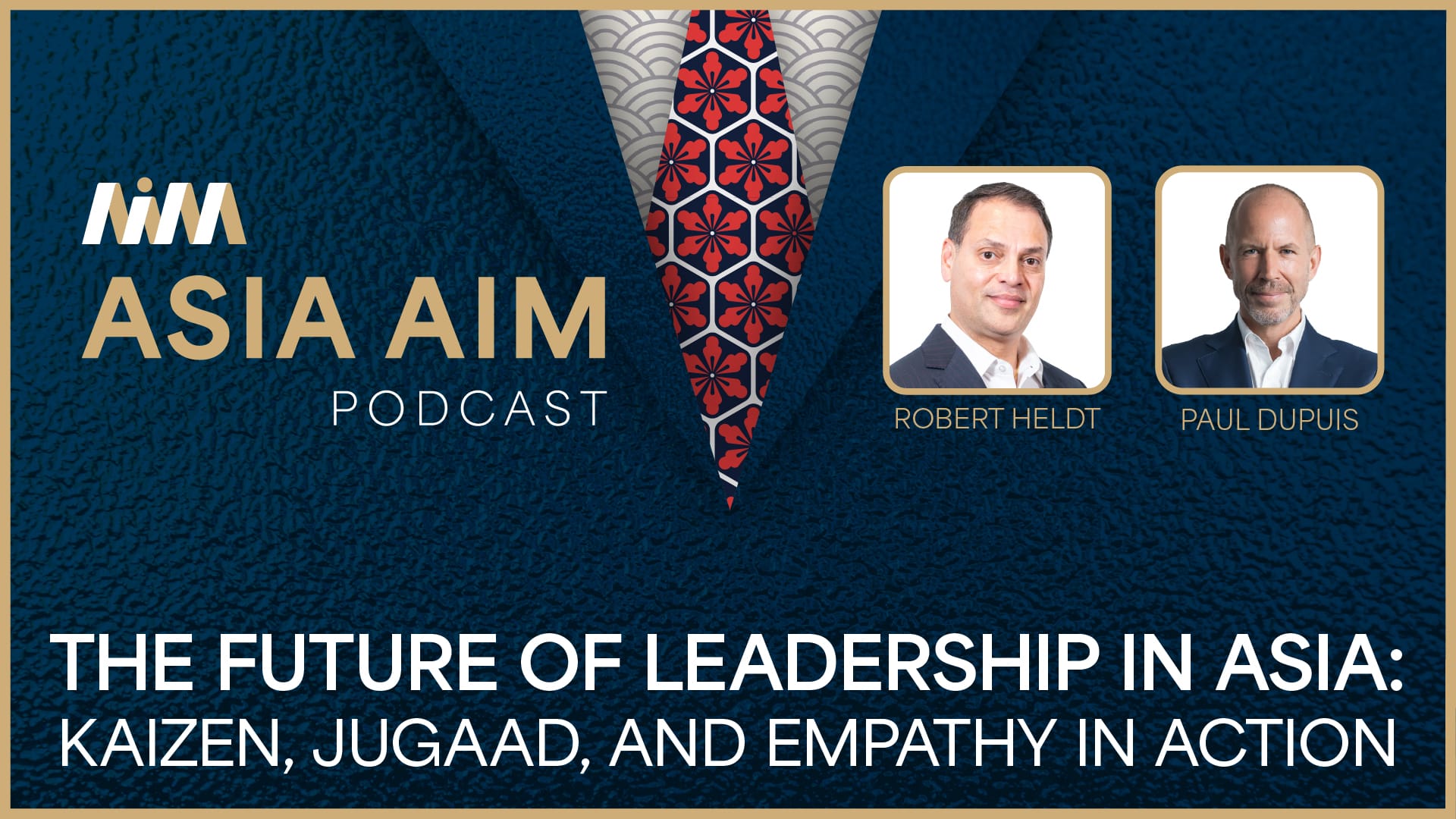- Podcast
・ November 19, 2025
Ep. 5 – The Future of Leadership in Asia: Kaizen, Jugaad and Empathy in Action

Cross-cultural leadership is arguably the most critical challenge facing business leaders in Asia today. It requires navigating vast differences in work culture, communication and market dynamics—from the methodical processes of Japan to the resourceful agility of India.
In Episode 5 of the Asia AIM Podcast, host Robert Heldt, CEO & Co-Founder of AIM B2B, welcomes leadership expert Paul Dupuis, the founder and CEO of Take-5 Global K.K.. Paul, who previously led Randstad Japan and India, shares his remarkable 35-year story: a journey from arriving in Japan as a backpacker to leading major billion-dollar organizations across the APAC region.
Recognized as one of India’s Best Leaders in Times of Crisis in 2021, Paul shares proven strategies for managing diverse teams and becoming a future-ready leader in today’s hybrid work environment. Ultimately, future-ready leaders in Asia must master the blend of universal honesty, localized cultural tools such as kaizen (continuous improvement) and jugaad (frugal innovation) and the active step of compassionate leadership.
Here are the key takeaways for leaders and marketers navigating Asia’s dynamic markets:
1. What is the 90/10 Formula for Cross-Cultural Leadership in Asia?
Paul Dupuis argues that effective leadership is, at its core, “timeless and borderless.” His major discovery is that 90% of effective leadership is universal, focused on human similarities rather than regional differences. Traits such as honesty, transparency and having your team’s back are essential everywhere.
The remaining 10% is the “magic dust” of localization. This requires understanding cultural nuances—such as the importance of kaizen in Japan or jugaad in India—to push the right buttons and levers within the local context.
2. What is the E5 Movement Framework for Transformational Leadership?
Paul, author of The E5 Movement, reveals his five-pillar framework for transformational leadership:
- Envision: Start not with what to achieve, but with why (purpose). As author Jim Rohn said, “When the why is clear, the how is easy.”
- Express: Leverage an omnichannel approach to consistently share the vision, which is crucial for multicultural teams in hybrid work environments.
- Excite: Build momentum by getting people to lean in and want to participate in the journey.
- Enable: Shift from holding the hammer to teaching others how to use it, creating an environment where everybody shines and can experiment.
- Execute: The ultimate non-negotiable step—bringing the vision to life for measurable impact.
3. How Do Leaders Combine Kaizen and Jugaad for Innovation?
One of the most profound cross-cultural lessons Paul discovered was balancing two seemingly opposite approaches to innovation:
- Kaizen (Japan): The philosophy of incremental, continuous improvement. It focuses on making small 1% gains consistently over time, which compound into massive cumulative results. It is slow and requires consensus.
- Jugaad (India): Embodies frugal innovation and creative resourcefulness. It’s about finding ingenious ways to quickly get things done with limited resources—a mindset driven by speed and ingenuity.
Paul emphasizes that combining kaizen’s meticulous focus on quality with jugaad’s spirit of creative urgency creates a “magical combination” for driving results in diverse markets.
4. What Defines a Future-Ready Leader: Empathy vs. Compassion?
Paul outlines the two critical “muscles” future-ready leaders must build:
A. Compassionate Leadership
During the COVID-19 crisis in India, Paul discovered that empathy was not enough. He needed compassion—empathy with action. Compassion means taking active steps to help team members overcome challenges, shifting the focus from results to safety, both physical and psychological.
B. Fluid Leadership and Humility
Future-ready leaders must develop fluid leadership abilities, moving between four quadrants as needed: directive, achievement-oriented, participative and supportive.
The key muscle is humility. Rather than operating in the “telling mode,” a leader must have the humility to admit when they don’t know the answer and ask for advice. The biggest game-changer Paul discovered was shifting his language. He said, “The four words I discovered were in many ways a game changer for me as a leader. Instead of saying, ‘I think,’ I shifted to asking this question, ‘What do you think?’”
This simple shift triggers the team’s creativity, gives them ownership, and unlocks potential solutions.
FAQ
A: The biggest game-changer was shifting the leader’s language from “I think…” to asking the team, “What do you think?” This simple change fosters creativity, ownership and unlocks potential solutions.
A: Empathy is the ability to feel what others feel, but it is not enough on its own. Compassion is defined as empathy with action. It means taking active steps to help team members overcome challenges, prioritizing safety (physical and psychological) over just results.
A: To hear more of Paul’s strategies, including the three critical questions a new leader should ask when taking the pulse of an organization, be sure to listen to the full episode of the Asia AIM Podcast.
To hear more of Paul’s strategies, including the three critical questions a new leader should ask when taking the pulse of an organization, be sure to listen to the full episode.
Subscribe now to the Asia AIM Podcast to unlock expert insights on tailoring strategies for APAC’s diverse markets.
Share
Listen to This Episode
Author
Category
- Strategy
- Branding





